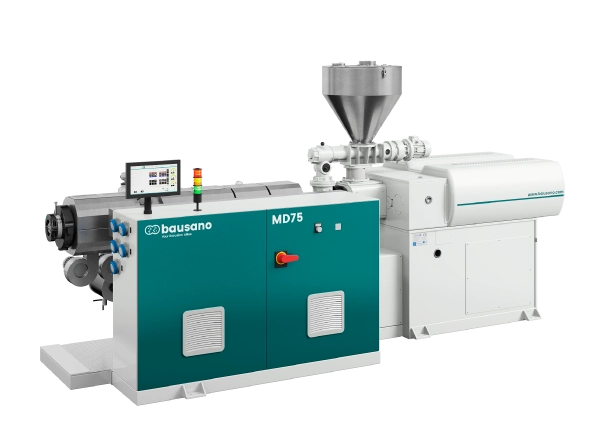Brief summary
The performance and capabilities of parallel and conical twin screw extruders are compared and contrasted. In particular, the processing behaviour of both systems is explored in the light of the extrusion requirements for specific PVC end use applications including pipe, profiles, pelletising and sheet.
Are Counter Rotating Twin Screws appropriate for PVC?
Fully intermeshing, counter rotating twin screw extruders are essentially positive displacement pumps independent of frictional criterion and are designed for thermally sensitive polymers such as PVC or C-PVC. During twin screw extrusion PVC/C-PVC is conveyed, compressed, degassed, plasticated ,sheared, kneaded, fused at optimum level and homogenized before it enters the die. PVC/C-PVC even undergoes degradation during processing. Type and quantity of filler used in compound: calcium carbonate improves the base properties of polyvinyl chloride by adding stiffness to the polymer matrix and improving impact resistance as particle sizes become smaller. Calcium carbonate also improves compounding performance by helping disperse various ingredients into the PVC powder blend and improves processing by making polymer flow more homogenous.
Enhanced Performance for PVC+100 p.h.r CaCO3
Parallel Counter-rotating Twin Screw Extruder is the better solution for working PVC+100 p.h.r CaCO3. Parallel Screw are longer than the conical one, in fact with a L/D ratio of 1/30 the former are well suggested in order to guarantee a good jellification of the material. The shape of parallel screw gives more time to the plasticization process, in order to better coat and amalgamate the high quantity of carbonate. The carbonate is a high corrosion material and this is a key point in terms of screw and barrel lifetime. With this type of application parallel screw has an higher resistance capacity against the corrosion action of carbonate filler due to the bigger and more resistant heart. This also guarantee a longer life of the barrel that in case of conical screw has a more expensive replacement cost.
Optimizing Melting Efficiency
Due to the high phr level of carbonate, the melting of the material is an important factor in order to obtain an output with high level of standard. So, if the carbonate is not well amalgamated and the polymeric part of the PVC is not well plasticized, the probability to obtain an easy breakable product is higher. All this risks can be avoided thanks to the parallel screw properties mentioned before.
_5f106191f0d79.jpeg)



